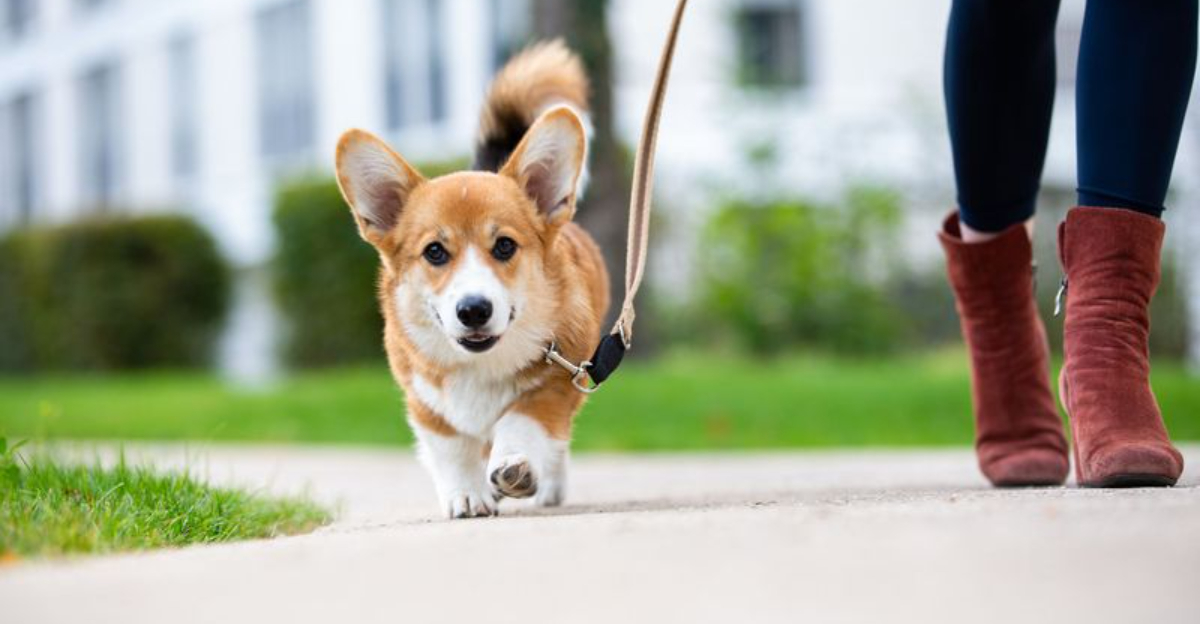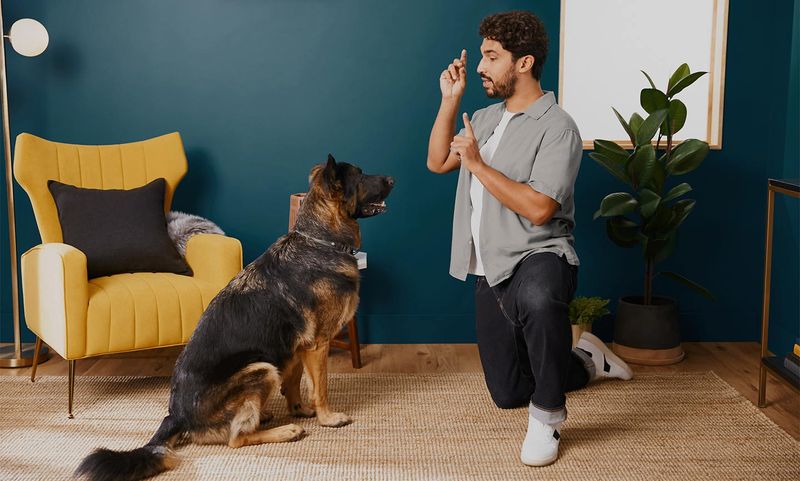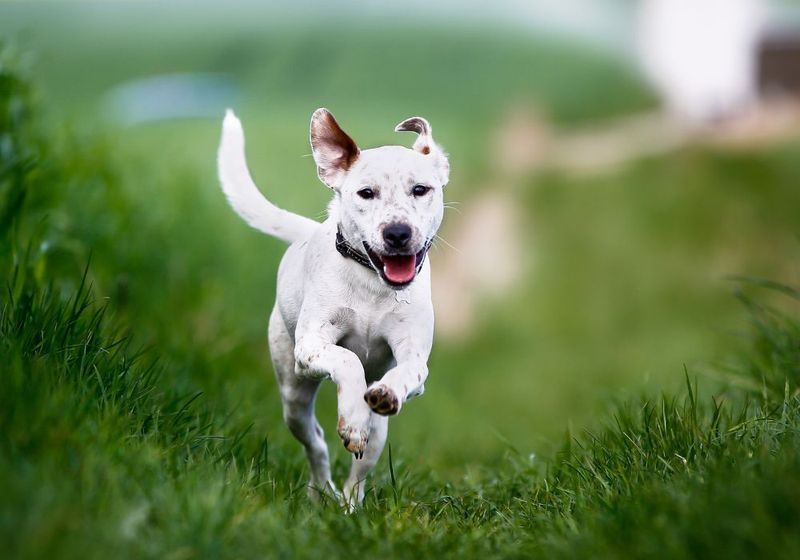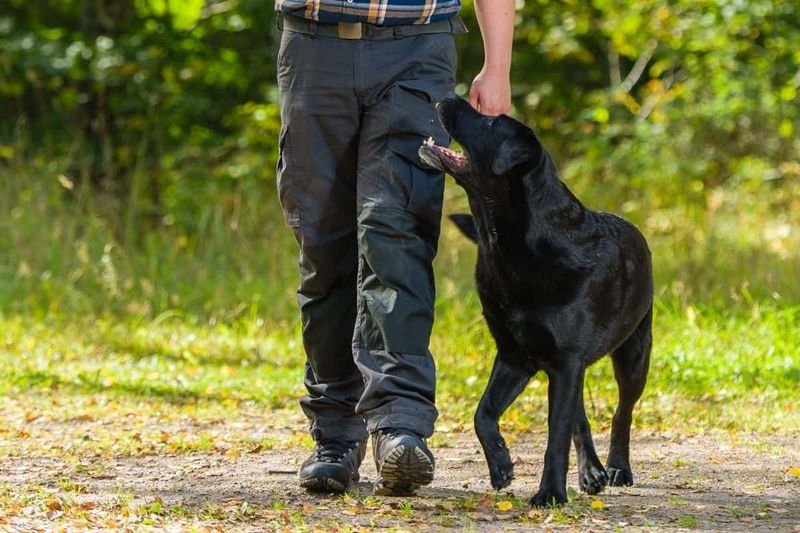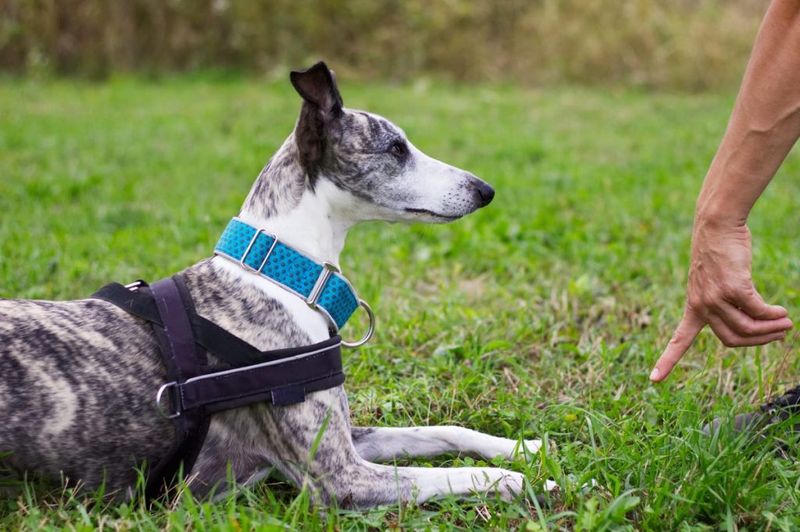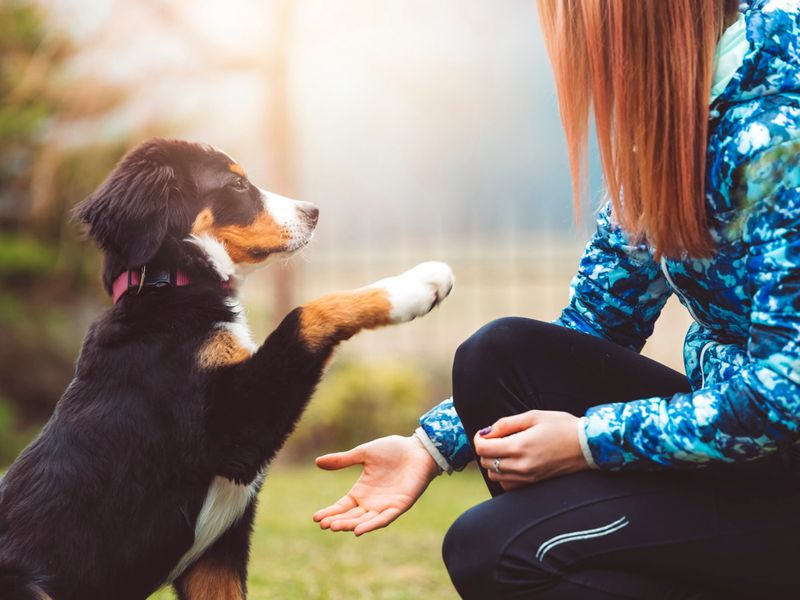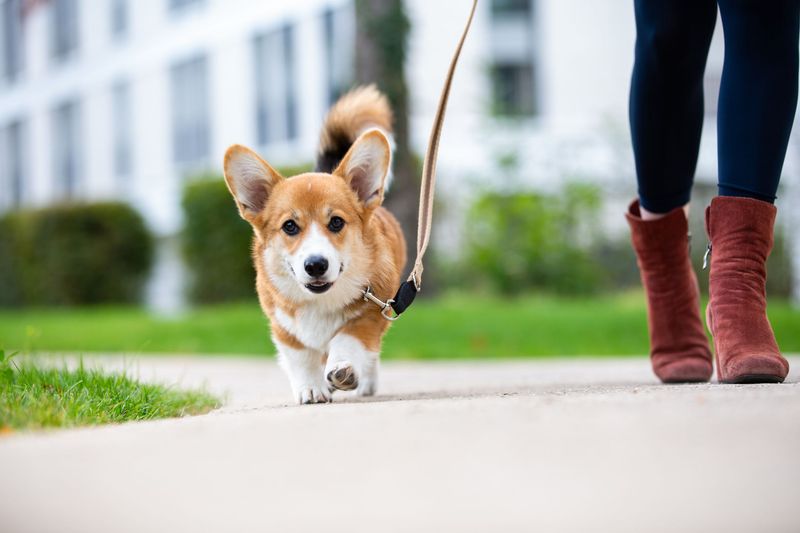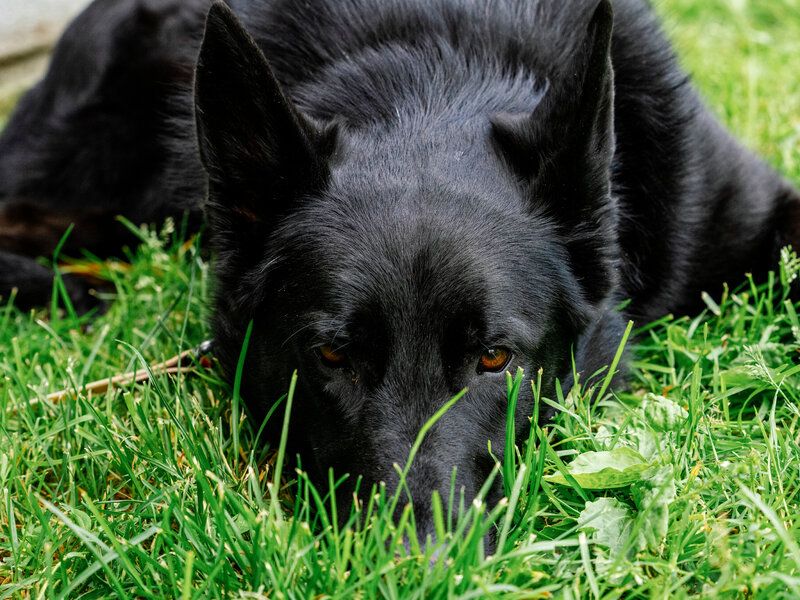Dogs may not understand everything we say, but they’re surprisingly adept at picking up on specific words. Their keen senses and instincts allow them to interpret certain commands while others might just be a mystery to them. Here’s a look at 11 words your furry friend likely understands and 7 that are probably Greek to them.
Sit
“Sit” is often one of the first commands a dog learns, and it’s a fundamental part of basic training. With a simple and clear sound, this word helps establish control and obedience in dogs. It also reinforces good behavior through positive reinforcement, such as treats or affection. Dogs understand this word as a call to attention, often associated with a reward. This command is universal among dog trainers and owners, making it a staple in canine vocabulary. The sound and structure of the word make it easy for dogs to recognize and respond promptly.
Stay
“Stay” is more than just a command; it’s a test of your dog’s patience and discipline. This word requires a dog to resist the natural urge to follow or explore. Teaching “stay” is crucial for safety and control, especially in bustling environments. It helps build trust between the owner and the dog, as obedience is rewarded. Dogs learn to associate the word with stillness and restraint, often waiting eagerly for the release command. With consistent practice, “stay” becomes a fundamental part of a dog’s understanding of human communication.
Fetch
The word “fetch” often brings joy and excitement to a dog’s day. It’s more than just a game; it’s a bonding experience between owner and pet. When a dog hears this command, they anticipate a fun chase, often returning with wagging tails and eager eyes. This interactive word encourages physical exercise and mental stimulation. Dogs quickly learn to associate “fetch” with retrieving objects like balls or frisbees. The playful tone of the word matches the joyful activity it represents, making it a cherished part of a dog’s life.
Come
“Come” is an essential command for ensuring your dog’s safety and recall abilities. It signifies a call for the dog to return to their owner’s side, which can be crucial in various situations. This word is often associated with positive experiences, like treats or affection, encouraging prompt response. The consistency of using “come” helps dogs understand its importance, as it may prevent them from wandering into danger. This command strengthens the bond between owner and dog, emphasizing trust and reliability in communication.
Heel
“Heel” commands a dog to walk closely next to its owner, fostering discipline and focus. This word is particularly useful during walks, ensuring the dog stays safe and attentive in crowded areas. Dogs learn to associate “heel” with walking in harmony, often rewarded with praise or treats. The word provides structure and control, allowing the owner to navigate various environments confidently. “Heel” enhances the walking experience, transforming it into a coordinated activity that strengthens the human-canine connection.
Down
The command “down” is useful for calming an overexcited dog or managing behavior. Dogs learn to associate this word with lying down, promoting relaxation and control. It’s often a follow-up to “sit,” reinforcing obedience through practice. The “down” command helps manage situations where dogs need to settle, such as greeting guests or during mealtime. This word ensures that dogs understand when to pause and relax, bridging communication between owner and pet. Consistent use of “down” establishes it as a key part of a dog’s vocabulary.
Leave it
“Leave it” is a vital command that prevents dogs from picking up potentially harmful objects. This phrase teaches restraint and control, keeping them safe from hazards. Dogs learn to focus on their owner’s cues, understanding that ignoring the object leads to rewards. This command is pivotal in maintaining safety during walks or at home. “Leave it” helps establish boundaries and trust, as dogs begin to prioritize the owner’s guidance over their instincts. Mastery of this command can prevent accidents and ensure a dog’s well-being.
No
The word “no” is one of the most straightforward commands, signaling disapproval or correction. It’s a crucial part of training, helping dogs understand boundaries and acceptable behavior. “No” is used to interrupt unwanted actions, encouraging dogs to reconsider their choices. Consistent use of this word helps reinforce the owner’s authority, guiding dogs towards positive behaviors. Dogs learn to associate “no” with halting their actions, often looking for cues on what to do instead. This simple word helps maintain order and discipline.
Good boy/girl
Praising words like “good boy” or “good girl” convey approval and affection, reinforcing positive behavior. Dogs thrive on praise, and these words boost their confidence and happiness. They learn to associate these words with rewards, such as treats or affection, motivating them to repeat good behavior. This form of communication strengthens the bond between owner and dog, creating a positive environment. Dogs eagerly respond to this praise, often wagging their tails in joy. The simplicity of these words allows for clear, heartfelt communication.
Okay
The word “okay” serves as a release command, often indicating permission or the end of a task. Dogs learn to associate “okay” with a transition, such as starting a meal or ending a command. This word helps manage timing and control, ensuring dogs wait patiently for cues. “Okay” fosters discipline and understanding, providing clarity in routines. For many dogs, hearing “okay” brings a sense of anticipation and readiness to engage in activities. It’s a versatile word, easily integrated into various aspects of daily life.
Walk
The word “walk” typically brings excitement and anticipation to a dog’s day. It’s often associated with adventure and exploration, as dogs relish the opportunity to explore new scents and environments. Hearing this word signals a change in routine, and dogs eagerly prepare for the outing. “Walk” is a cherished part of a dog’s vocabulary, symbolizing freedom and fun. The joy and enthusiasm it evokes strengthen the bond between dog and owner. This simple word connects to the promise of outdoor escapades.
Tomorrow
Time-based words like “tomorrow” often perplex dogs, as they lack an understanding of days or future events. Dogs focus on the present, reacting to immediate stimuli rather than abstract concepts. While they can learn routines, the idea of “tomorrow” is beyond their comprehension. This word lacks the immediacy and clarity needed for dogs to form an association. As a result, “tomorrow” is just a sound with no significance, highlighting the limitations of canine cognition. Dogs live in the moment, guided by tangible experiences.
Later
Words like “later” fail to resonate with dogs, as their sense of time differs from humans. Dogs respond to the present, finding no meaning in postponed actions. The concept of “later” lacks the direct correlation needed for dogs to connect it to an action. Their world revolves around immediate responses and cues, rendering “later” an abstract term. This limitation showcases the gap in understanding between human language and canine perception. Dogs prioritize present interactions, unable to grasp future-oriented words like “later.”
Maybe
The uncertainty of words like “maybe” is beyond a dog’s understanding. Dogs seek clear, definitive cues, making “maybe” a foreign concept. This word offers no assurance or direction, leaving dogs puzzled by its ambiguity. In the canine world, actions and commands need clarity and consistency. “Maybe” introduces doubt, disrupting the straightforward communication dogs rely on. As creatures of habit, dogs thrive on certainty, rendering “maybe” an ineffective word in their vocabulary. This illustrates the importance of direct, unambiguous language for dogs.
Why
Abstract questions like “why” elude a dog’s comprehension, as they focus on action rather than reasoning. Dogs perceive the world through experiences and responses, lacking the cognitive framework for introspection. The concept of “why” requires a level of reasoning and understanding that dogs don’t possess. Instead, they react to tangible cues and commands, forming associations based on direct interactions. The word “why” remains a mystery, illustrating the cognitive differences between humans and dogs. Dogs flourish in environments with clear, actionable language.
If
Conditional words like “if” belong to the realm of complexity that dogs can’t navigate. The concept of “if” involves hypothetical scenarios and possibilities, which dogs don’t process. Their understanding is rooted in direct cause-and-effect, lacking the ability to interpret nuanced conditions. “If” introduces uncertainty and speculation, elements absent from a dog’s perception. This word highlights the cognitive divide between human abstract thought and canine simplicity. Dogs rely on straightforward communication, thriving in environments with clear directives.
Because
Causal words like “because” are foreign to a dog’s understanding, as they don’t process the reasoning behind actions. Dogs respond to immediate stimuli, forming associations with direct outcomes. The concept of “because” requires a grasp of cause-and-effect beyond a dog’s cognitive reach. This word illustrates the gap between human logic and canine response patterns. Dogs thrive on actionable language, responding to cues without needing to understand underlying reasons. “Because” remains an enigma, emphasizing the way dogs perceive and interact with the world.
Reason
Abstract nouns like “reason” are beyond a dog’s comprehension, as they focus on action rather than logic. Dogs live in the moment, guided by instincts and learned behaviors. The concept of “reason” requires cognitive processing that dogs don’t possess. Instead, they react to direct commands and cues, forming associations based on experience. “Reason” remains an abstract thought, highlighting the cognitive differences between humans and dogs. Dogs excel in environments with clear, actionable language, thriving on tangible interactions.
